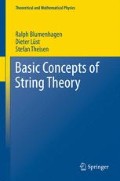Abstract
The fermionic string theory presented in this and the following chapter is the Neveu-Schwarz-Ramond spinning string. We present the world-sheet action and discuss its symmetries, most notably the local N = 1 world-sheet supersymmetry. The admissible periodicity and boundary conditions lead to the distinction between Neveu-Schwarz and Ramond sectors. The oscillator expansions of the world-sheet fermions differ in the two sectors. We close with an appendix on spinors in two dimensions. Quantisation of the fermionic string will be the subject of the following chapter.
Access this chapter
Tax calculation will be finalised at checkout
Purchases are for personal use only
Notes
- 1.
We denote the amount of world-sheet supersymmetry by Nand reserve \(\mathcal{N}\)for space-time supersymmetry.
- 2.
Under general coordinate transformations, tensor indices are acted on with elements of \(GL(n, \mathbb{R})\).
- 3.
In any number of dimensions it is \({\overline{\chi }}_{\alpha }{\Gamma }^{\alpha \beta \gamma }{D}_{\beta }{\chi }_{\gamma }\)where \({\Gamma }^{\alpha \beta \gamma }\)is the anti-symmetrized product of three Dirac matrices which vanishes in two dimensions.
- 4.
The fields and parameters have mass dimensions \([\psi ]\,=\,[\chi ]\,=\,1/2\), \([\epsilon ]\,=\, - 1/2\), \([\xi ]\,=\,[X]\,=\, - 1\). All others are dimensionless. The fact that we choose Xto have dimension of length, rather than being dimensionless, as is more common for a scalar field in two dimensions, is the origin of the various powers of \(\sqrt{{ 2 \over \alpha \prime } }\).
- 5.
In later chapters we will also use the notations ψ L and \(\overline{\psi }\)for left-moving fermions and \({\psi }_{R}\)and ψ for right-moving fermions.
- 6.
For anticommuting variables they are defined as
$$\{F,{G\}}_{\mathrm{P.B.}} = \left ({ \partial F \over \partial {q}^{i}} { \partial G \over \partial {p}_{i}} -{ \partial F \over \partial {p}_{i}} { \partial G \over \partial {q}^{i}} \right ) + {(-1)}^{{\epsilon }_{F}}\left ({ \partial F \over \partial {\theta }^{\alpha }} { \partial G \over \partial {\pi }_{\alpha }} +{ \partial F \over \partial {\pi }_{\alpha }} { \partial G \over \partial {\theta }^{\alpha }} \right )$$(7.44)where (q, p) are the usual Grassmann even phase-space variables and \({\theta }^{\alpha }\)and \({\pi }_{\alpha } ={ \partial \mathcal{L} \over \partial {\theta }^{\alpha }}\)are Grassmann odd phase-space variables. Fand Gare functions on phase-space and \({\epsilon }_{F}\)is the Grassmann parity of F, i.e. \({\epsilon }_{F} = 0(1)\)for Feven (odd). All derivatives are left-derivatives. The canonical Hamiltonian is defined as \(H =\dot{ q}p +\dot{ \theta }\pi - L\)where the order in the second term matters.
Author information
Authors and Affiliations
Rights and permissions
Copyright information
© 2012 Springer-Verlag Berlin Heidelberg
About this chapter
Cite this chapter
Blumenhagen, R., Lüst, D., Theisen, S. (2012). The Classical Fermionic String. In: Basic Concepts of String Theory. Theoretical and Mathematical Physics. Springer, Berlin, Heidelberg. https://doi.org/10.1007/978-3-642-29497-6_7
Download citation
DOI: https://doi.org/10.1007/978-3-642-29497-6_7
Published:
Publisher Name: Springer, Berlin, Heidelberg
Print ISBN: 978-3-642-29496-9
Online ISBN: 978-3-642-29497-6
eBook Packages: Physics and AstronomyPhysics and Astronomy (R0)

